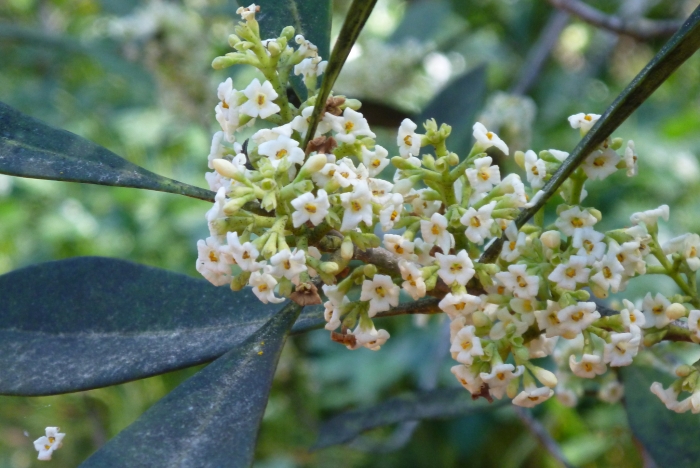American Olive
(Cartrema americana)
American Olive (Cartrema americana)
/
/

mfeaver
CC BY 4.0
Image By:
mfeaver
Recorded By:
Copyright:
CC BY 4.0
Copyright Notice:
Photo by: mfeaver | License Type: CC BY 4.0 | License URL: http://creativecommons.org/licenses/by/4.0/ | Rights Holder: mfeaver | Publisher: iNaturalist | Date Created: 2016-03-20T12:44:09-07:00 |

























Estimated Native Range
Summary
Cartrema americana, commonly known as American Olive or Devilwood, is an evergreen shrub or small tree native to the coastal plains, maritime forests, and wetlands of the southeastern United States, extending into Mexico. It typically grows to a height of 13-23 feet with a similar spread, and features leathery, glossy leaves that are 2-6 inches long. The plant is notable for its small, fragrant white flowers that bloom in early spring, creating a visually appealing display. These are followed by dark blue drupes that attract birds and other wildlife. The bark of mature trees is gray and can become deeply furrowed with age.
American Olive is valued for its year-round foliage and fragrant spring flowers, making it a desirable addition to residential landscapes, naturalized areas, and wildlife gardens. It is relatively low-maintenance and can adapt to a range of garden conditions. This species prefers well-drained soils but can tolerate occasional wetness, and it grows best in full sun to partial shade. While it is not commonly afflicted by serious pests or diseases, it can occasionally suffer from leaf spot or dieback. It is also resistant to damage from deer. Due to its dense growth habit, it can be used as a screen or hedge.CC BY-SA 4.0
American Olive is valued for its year-round foliage and fragrant spring flowers, making it a desirable addition to residential landscapes, naturalized areas, and wildlife gardens. It is relatively low-maintenance and can adapt to a range of garden conditions. This species prefers well-drained soils but can tolerate occasional wetness, and it grows best in full sun to partial shade. While it is not commonly afflicted by serious pests or diseases, it can occasionally suffer from leaf spot or dieback. It is also resistant to damage from deer. Due to its dense growth habit, it can be used as a screen or hedge.CC BY-SA 4.0
Plant Description
- Plant Type: Shrub, Tree
- Height: 10-30 feet
- Width: 6-30 feet
- Growth Rate: Moderate
- Flower Color: Brown, Cream
- Flowering Season: Spring
- Leaf Retention: Evergreen
Growth Requirements
- Sun: Part Shade
- Water: Medium
- Drainage: Slow
Common Uses
Bird Garden, Butterfly Garden, Deer Resistant, Erosion Control, Low Maintenance, Street Planting
Natural Habitat
Coastal plains, maritime forests, and wetlands
Other Names
Common Names: American Bladdernut, Fisherman’s friend
Scientific Names: , Cartrema americana, Amarolea americana, Cartrema americana, Cartrema americana, Cartrema odorata, Olea americana, Olea laeta, Osmanthus americanus, Osmanthus americanus var. americanus
GBIF Accepted Name: